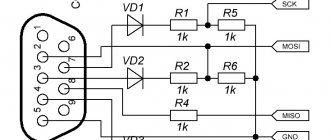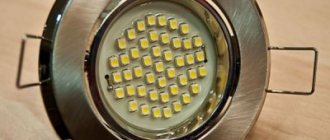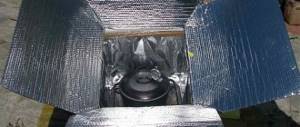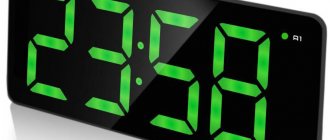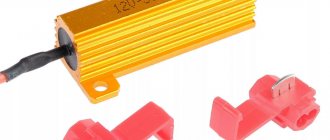Scheme of running lights - the sun
To animate any toys, for a gift, or just for creativity, you can put together a “running fire” diagram.
The effect of creating lights running from the center to the edges. Very similar to the rays of the sun. Characteristics:
- Number of channels - 3;
- Number of LEDs - 18 pcs;
- Upit.= 3…12V.
“Running fire” circuit on K561LA7 (CD4011)
Of course, LEDs can be taken in any colors and in different quantities. But you may have to select the resistance R7, R8, R9 (51 Ohm). If LEDs are used of different types in one arm, then you will have to install not one common resistance, but a different resistance for each LED (select according to the brightness of the glow).
You can assemble the same circuit using transistors.
Circuit "running fire" on transistors
Transistors can be taken from any low-frequency, low-power reverse conductivity (npn) domestic or imported analogues.
You can arrange the LEDs in any order, and also use not multi-colored LEDs, but, for example, only red ones.
You can arrange the LEDs in the shape of a heart!
SHARE WITH YOUR FRIENDS
Scheme and principle of its operation
In the center of the circuit diagram there is an ATtiny2313 microcontroller, with LEDs connected to its 13 pins. In particular, to control the glow, port B (PB0-PB7), 3 pins of port D (PD4-PD6), as well as PA0 and PA1, which remained free due to the internal generator used, are fully used. The first pin PA2 (Reset) does not actively participate in the circuit and is connected to the MK power circuit through resistor R1. The plus of the 5V power supply is supplied to the 20th pin (VCC), and the minus is supplied to the 10th pin (GND). To eliminate interference and malfunctions in the operation of the MK, a polar capacitor C1 is installed on the power supply.
Taking into account the small load capacity of each pin, LEDs rated for a rated current of no more than 20 mA should be connected. These can be either super-bright LEDs in a DIP package with a transparent lens, or smd3528. There are a total of 13 of them in this pattern of running lights. Resistors R6-R18 act as current limiters.
The numbering of the LEDs in the diagram is indicated in accordance with the firmware.
Through the digital inputs PD0-PD3, as well as using the SB1-SB3 buttons and the SA1 switch, the operation of the circuit is controlled. All of them are connected through resistors R2, R3, R6, R7. At the software level, there are 11 different variations of LED blinking, as well as sequential selection of all effects. The program selection is set by the SB3 button. Within each program, you can change the speed of its execution (LED blinking). To do this, switch SA1 is moved to the closed position (program speed) and the speed increase (SB1) and speed decrease (SB2) buttons are used to achieve the desired effect. If SA1 is open, then buttons SB1 and SB2 will adjust the brightness of the LEDs (from weak flickering to glowing at rated power).
P O P U L A R N O E:
At parties and discos, you could often see multi-colored color music and strobe lights.
Let's see how we can make such a circuit at home using multi-colored LEDs. In this article we will look at two simple circuits of a very effective LED strobe light.
How to quickly make tracks on a board?
The easiest and fastest way to make PCBs for small circuits using a cutter.
No need for a printer, etching solutions, etc.
This method is suitable for quickly producing a printed circuit board for simple amateur radio circuits.
Many people have bicycles. I want it to be always reliable and beautiful! Without special expenses and unnecessary wires, using magnets and LEDs, you can create a beautiful effect. When driving, especially in the dark, there will be a multi-colored glow inside the bicycle wheel.
3 comments on “Scheme of running lights - the sun”
This circuit can be taken as a basis, and the LEDs can be arranged in different ways. For example, a Christmas tree or to animate some kind of toy, etc.
assembled on a solderless breadboard 315 do not fit into the board well, tried without transistors and resistors R4-6 for each channel connected only three LEDs in parallel works from 5 volts resistors R7-9 set to 270 ohm ——- how many LEDs per channel will the chip without transistors withstand ? and how many LEDs can be connected through a transistor?
It is better not to load the microcircuit and install transistors that fit into the circuit board. How many LEDs can be loaded onto a transistor depends on the transistor.
your comment
– NAVIGATOR –
Subscribe RSS
Subscribe to our RSS feed to receive site news. Stay connected!
Printed circuit board and assembly parts
Especially for beginner radio amateurs, we offer two options for assembling running lights: on a breadboard and on a printed circuit board. In both cases, it is recommended to use a chip in a PDIP package installed in a DIP-20 socket. All other parts are also in DIP packages. In the first case, a 50x50 mm breadboard with a pitch of 2.5 mm will be sufficient. In this case, the LEDs can be placed both on the board and on a separate line, connecting them to the breadboard with flexible wires.
The printed circuit board in .lay6 format can be downloaded here.
If LED running lights are intended to be actively used in the future (for example, in a car, bicycle), then it is better to assemble a miniature printed circuit board. To do this, you will need a one-sided textolite measuring 55*55 mm, as well as radio elements:
- C1 – 100 uF-6.3V;
- DD1 – ATtiny2313;
- HL1-HL13 – LED of any color with a diameter of 3 mm;
- R1 – 10 kOhm-0.25 W±5%;
- R2-R18 – 1 kOhm-0.25 W±5%;
- SB1-SB3 – tact button KLS7-TS6601 (any similar);
- SA1 is a three-pin slide switch of ESP1010.
For those who have experience in manufacturing printed circuit boards, it is better to use ATtiny2313 SOIC form factor, as well as SMD resistors. This will reduce the size of the device by approximately 2 times. You can also take super-bright SMD LEDs and place them in a separate block.
To flash the ATtiny2313 MK firmware, you should use a homemade programmer connected to the computer’s RS-232 and known to many as PonyProg2000. Before flashing the firmware, you must set the fuses in accordance with the table.
Firmware for running lights on ATtiny2313 can be downloaded here.
Views
- A simple and reliable do-it-yourself metal detector – 201,869 views.
- DIY microwave oven repair – 187,685 views.
- Simple DIY metal detector – 183,515 views.
- Charger from a computer power supply. – 180,970 views.
- Car chargers. Scheme. Principle of operation. – 155,875 views.
- A simple and reliable thermostat circuit for an incubator - 144,375 views.
- Simple automatic charger - 110,694 views.
- DIY moonshine still – 109,811 views.
- How to change the USB connector yourself? – 102,459 views.
- A variety of simple circuits on the NE555 - 101,979 views.
Translator
We are in social networks:
Briefly about the site:
Master Vintik. Everything with your own hands!
– this is a site for those who like to make, repair, and create with their own hands! Here you will find free reference books and programs. The site contains simple diagrams, as well as tips for DIY beginners. Some of the repair schemes and methods were developed by the authors and friends of the site. The rest of the material is taken from open sources and is used for informational purposes only.
Do you like to tinker and make crafts? Send photos and descriptions to our website by email
or through the form.
Programs, diagrams and literature - all FREE!
If you like the site, add it to your favorites (press Ctrl + D)
, and you can also subscribe to RSS news and always receive new articles on the feed. If you have a question about a pattern or craft? Welcome to our forum! We are always happy to provide assistance in setting up circuits, making repairs, and making crafts!
ATtiny2313 microcontroller for running lights
This device belongs to the AVR series of microcontrollers from the Atmel brand. It is under his control that a running light strip is most often made, since the performance characteristics of the model are quite high. Microcontrollers are easy to program, multifunctional and support the implementation of various electronic devices.
ATtiny2313 is made according to a simple design, where the output and input ports have identical meanings. Selecting a program (one of 12) on such a microcontroller is very easy, because it is not overloaded with unnecessary options. The model is available in two packages - SOIC and PDIP, and each option has identical characteristics:
- 8-bit general registers in the amount of 32 pieces;
- capabilities of 120 operations per clock cycle;
- 2 kB flash memory inside the system with support for 10 thousand erase and write cycles;
- 128 byte in-system EEPROM with support for 100 thousand cycles;
- 128 bytes of built-in RAM;
- 4 PWM channels;
- 8 and 16 bit counter-timer;
- built-in generator;
- convenient interface for various purposes and other functions.
The microcontroller has two types in accordance with energy parameters:
- the classic ATtiny2313 model has a voltage from 2.7 to 5.5 V and a current of up to 300 μA at a frequency of 1 MHz in activity mode;
- the ATtiny2313A (4313) variant has characteristics of 1.8-5.5 V and 190 μA at the same frequency.
In standby mode, the device has a power consumption of no more than 1 µA.
Scheme of running lights and the principle of its operation
The created LED running lights circuit is based on placing the microcontroller in the center. All its output ports are connected to LEDs:
- port B or PB0-PB7 is used entirely to control the glow;
- three pins from port D (PD4-PD6) are used as much as possible;
- PA0 and PA1 also work, since they are free due to the implemented internal oscillator.
Pin No. 1 - PA2 or Reset - is not an active link in the circuit, so resistor R1 is connected to the ATtiny2313 power circuit. The positive part of the 5 V supply goes to pin No. 20 - VCC, and the negative part - No. 10 (GND). Polar capacitor C1 is installed to prevent failures and suppress interference in the operation of the MK.
Considering that each pin has a low load capacity, it is advisable to install LEDs with a rating of up to 20 mA on them.
Both classic smd3258 and high-brightness LEDs in a DIP package are suitable. There should be 13 of them in total. The current limiting function is assigned to resistors R6-R18.
The operation of the circuit is controlled through switch SA1, buttons SB1-SB3 and digital inputs PD0-PD3, which are connected through resistors R2, R3, R6 and R7. This design allows you to turn on the LEDs blinking in 11 different modes by setting a specific program with the SB3 button. And using switch SA1, the flashing speed is changed. For this:
- SA1 is moved to the closed position.
- The speed is changed using the SB1 (acceleration) and SB2 (deceleration) buttons.
Please note that when you open the switch with these buttons, the brightness of the LEDs changes from barely noticeable flickering to maximum power.
A simple circuit of LED running lights
Components for this project
2 x 2N2222A (NPN Transistor) 2 x 22uF - 50V capacitor (polarized) 2 x 46k Ohm resistor (1/4W) Bright white LED 6 x 8mm 12V power supply
Principle of operation
From the circuit diagram it is clear that the project is based on a simple Astable Multivibrator. When the circuit is turned on, one transistor will be on (in saturation mode) and the other will be off (in cutoff mode).
Assuming T1 is on and T2 is off, capacitor C2 will charge through the series LEDs. Since the LEDs are connected in the current path, they will light up.
During this time, transistor T2 is turned off due to the discharge capacitor C1 (since the negative plate is connected to the base of Q2). After the time constant C1R1, capacitor C1 is completely discharged and begins to charge through R1.
The charging direction is reversed. When the capacitor charges, it produces enough voltage (0.7 V) to turn on transistor T2. At this time, capacitor C2 begins to discharge through Q2.
When the plate of capacitor C2, which is connected to the base of transistor T1, turns negative, transistor T1 turns off and this set of LEDs turns off.
Now capacitor C1 begins to charge from the corresponding series LEDs (via base T2). Since this set of LEDs are connected in the current path, they will be turned on.
Now capacitor C2 is discharged and after complete discharge it begins to charge through R2. As charge accumulates in capacitor C2, when the voltage reaches 0.7V, it will turn on transistor T1. From this point on, the process repeats as before. Accordingly, the effect of running lights is created.
Assembly options
There are two accessible and relatively simple options for assembling running lights: on a printed circuit board or a breadboard. In both cases, it is advisable to take the circuit in a PDIP package on a DIP-20 socket as a basis. In this case, it is necessary that the remaining components are also in DIP packages.
When assembling on a breadboard, a 50x50 mm model with a pitch of 2.5 mm will be sufficient. LEDs can be placed not only on the board itself, but also on an external strip, connecting them to the circuit using flexible wires.
A miniature printed circuit board is a more practical option for those cases when LED running lights are made with your own hands for further active use.
For example, when they are installed on a bicycle or car. In this case, you will need the following components:
- one-sided textolite 55×55 mm;
- capacitor 100 uF-6.3V;
- DD1 – Attine 2313;
- resistor 10 kOhm-0.25 W±5% (R1);
- 17 resistors 1 kOhm-0.25 W±5% (R2-R18);
- 13 LEDs with a diameter of 3 mm (color is not important);
- 3 buttons KLS7-TS6601 or equivalent (SB1-SB3);
- slide switch ESP1010 (SA1).
Radio amateurs with practical experience in assembling printed circuit boards are better off using Attine2313 SOIC with SMD resistors for this circuit. Due to this, the overall dimensions of the circuit will be reduced by almost half. You can also install super-bright SMD LEDs as a separate unit.
Scheme of running LED lights on a chip
The second project in the LED running lights series is a circuit using a CD4017 Decade Counter and a 555 Timer IC.
Required Components
1 x CD4017 decade counter IC 1 x 555 timer IC 1 x 18 kOhm resistor (1/4 W) 1 x 2.2 k Ohm resistor (1/4 W) Potentiometer 1 x 100 kOhm 1 x 1 uF - 50 V capacitor (polarized ) Ceramic disk capacitor 1 x 0.1 nF (code 100 pF 101) 10 x 8 mm bright white LEDs 5 V power supply
The principle of operation of the LED running lights circuit using a microcircuit
In this project, we designed a simple circuit in which the LEDs turn on one after the other and give us the effect of one LED chasing another. Let's see how it works.
The first thing you can see in the circuit diagram is that there are two parts: a 555 timer part and a CD4017 integrated counter part with LEDs. The 555 timer IC in this project is configured as an astable multivibrator.
In this mode, it generates a pulse whose frequency is determined by the components R1 (2.2 kΩ), R2 (18 kΩ), VR1 (100 kΩ) and C1 (1 μF). The pulse frequency can be controlled by adjusting the 100kΩ POT.
This pulse is fed to the CD4017 decade counter IC as its clock input. Understanding the operation of the CD4017, for every clock pulse it receives at the clock input, the count is incremented by 1 and as a result, each output pin will be HIGH for each corresponding clock pulse.
Since this is a decimal counter, we will get a count of 10, and since we have connected bright white LEDs to the output pins, each LED will turn on when the corresponding pin goes HIGH.
After 10 clock pulses, the countdown is reset and starts from the beginning. If the LEDs were placed in a circle, we get the feeling of chasing the LEDs.
Running lights at 12V
This 12 volt running lights circuit is widely known on the network, as it has a very simple and understandable design. The mode generator is a pulse timer, and the counter, counting them, supplies the corresponding logical levels to the outputs. The LED element connected to each output lights up at a logical one and goes out at zero. The effect of running lights is created by sequential flickering. The “running” speed is set by a generator, the operation of which is controlled by the nominal parameters of capacitor C1 and resistor R1.
The brightness of LEDs is enhanced by increasing the supplied current, but for this they must be connected through buffer transistors. The fact is that the counter outputs do not have a high load capacity.
This old diagram shows Soviet designations for components and microcircuits, but nowadays it is not difficult to find foreign-made analogues corresponding to them.
Running fire with 10 LEDs
One of the most popular lighting effects implemented in various designs of devices used to decorate a New Year tree is the effect of the so-called running lights. Visually, it is expressed in the fact that in a chain of any light sources, for example light bulbs, in the simplest version, one or a group of sources located one next to the other lights up in turn. At the same time, thanks to the inertia of our vision, it appears that the light source is moving, “running” along the chain at a certain speed. Not only light bulbs, but also, for example, LEDs can be used as light sources in such structures. A simple and at the same time reliable device that realizes the lighting effect of running lights can be assembled using ordinary LEDs. The proposed design is a conventional switch in which the supply voltage is alternately supplied to one of ten LEDs. The schematic diagram of the running lights module is shown in the figure.
This device, which is based on two microcircuits and ten transistors, can be divided into three functional blocks: a master oscillator, a control unit and an indication circuit. Like most similar designs, the proposed module is made using pulse counters. The master oscillator, which generates control pulses, is made on microcircuit IC2, which is connected according to an astable multivibrator circuit. In this case, the operating frequency of the master oscillator is determined by the resistance value of resistor R1 and the capacitance value of capacitor C1. When using these elements with the parameters indicated on the circuit diagram, the repetition rate of control pulses will be about 15 Hz. From the output of the master oscillator (pin IC2/3), control pulses are supplied to the control unit, which is based on microcircuit IC1, which is a pulse counter. The ten outputs of this microcircuit provide sequential generation of a logical unit voltage. Initially, all outputs of the pulse counter contain logical zero voltages. In other words, the voltage level at each of the outputs of the IC1 microcircuit (pins IC1/1-7.9-11) will be low and insufficient to open the transistor, the base of which is connected to the corresponding output.
When the first control pulse is received from the master oscillator at the input of the counter CLK (pin IC1/14), a logic one voltage will be generated at output D00 (pin IC1/3), that is, a voltage of a higher level will be applied to this output. Thus, a control voltage will appear at one of the outputs of the control unit, which is supplied to the corresponding input of the display unit. In the circuit under consideration, the display unit is made of transistors T1-T10 and LEDs D1-D10.
From output D00 (pin IC1/3), a high logic level voltage is supplied to the base of transistor T10 and ensures its unlocking. As a result, through the open collector-emitter junction of the T10 transistor, the anode of the LD10 LED is connected to the plus of the power source, which leads to the glow of this diode. The arrival of the next control pulse from the master oscillator at the input of microcircuit IC1 will ensure the formation of a logic one voltage at output D01 (pin 1C 1/2). In this case, a low logic level voltage will again appear at output D00, transistor T10 will close, and LED LD10 will go out. At the same time, transistor T9 will open, and diode LD9 will begin to glow.
When a continuous sequence of ten control pulses is applied to the input of counter IC1, a high logic level voltage will be alternately generated at outputs D00-D09, which will ensure sequential flashes of LEDs from LD10 to LD1. If these LEDs are placed one next to the other, then, as already noted, thanks to the inertia of our vision, the appearance of this will be created. that the glowing diode “runs” along the chain. After the next sequence of ten control pulses is applied to the counter input, a repeat cycle of alternating LED flashes will occur. And this will continue until the power is turned off. It remains to add that the use of transistors T1-T10 in this circuit as switches that control the operation of LEDs is due to the fact that the current load of the IC1 microcircuit is very insignificant. Therefore, directly connecting individual LEDs to its outputs can lead to a malfunction of the microcircuit. At the same time, taking into account the fact that at a certain moment in time only one LED is always lit in the proposed design, the current through all diodes is limited by one common resistor R2. All parts of the running lights module are placed on a small double-sided printed circuit board measuring 55x35 mm. An image of the printed circuit board is shown in the figure.
The module is powered from a constant voltage source of 5 V. This can be an ordinary flat battery of type 3336L or four 1.5 V AA cells, since reliable operation of this module is ensured even when the supply voltage changes in the range from 4.5 to 6.0 B. As a power source, you can use a conventional mains rectifier with a voltage of 6 V at a current of 200-300 mA. If LEDs with low operating current (2 mA) are used in this design, and the resistance of resistor R2 is increased to 1 kOhm, the total power consumption of the device will be significantly reduced. In this case, when powered by one coin cell battery, the module can operate continuously for several tens of hours. Imported BC548V transistors can be replaced, for example, with domestic KT3102VM npn-type transistors. LEDs can be replaced with small light bulbs, designed, for example, for a voltage of 4.5 V. In this case, resistor R2 is replaced with a jumper. In the proposed version of the running lights module, all LEDs are placed along one side of the printed circuit board. However, in each specific case, the location of the LEDs depends only on the imagination of the performer. LEDs can be arranged, for example, in the form of a small garland. It could be any letter or initials. In this case, the LEDs are connected to the board using a thin multi-core cable. Assembled without errors in installation and from serviceable parts, the running lights module requires almost no adjustment, with the exception of selecting the operating frequency of the master oscillator, which is determined by the resistance value of resistor R1 and the capacitance value of capacitor C1. If desired, the speed of movement of the running lights can be changed by selecting the resistance value of resistor R1. To increase the speed, the resistance of resistor R1 should be reduced, and to reduce the speed of movement of the running lights, the resistance of resistor R1 should be increased.
Running lights
LED running lights are one of the options for an automatic device based on LED lighting devices or simpler types, which are quite widely used in advertising lighting structures, as well as in the automotive industry. At its core, this is a device that controls LEDs and devices based on them strictly in accordance with the program embedded in the microcircuit.
Devices based on programmable controllers are very popular when controlling lighting devices. Most running lights work on this principle. Among the mass-produced, most common control chips is the eight-bit controller chip with a PIC12F629 memory drive. And the simplest device that you can make with your own hands using it is reversible running lights, i.e., those that alternately switch on LEDs or other light sources back and forth.
The circuit of such a device is quite simple and contains only a control device with the corresponding program already stored in memory. The voltage is supplied from a stabilized power source of five or twelve volts using an additional integrated stabilizer.
More complex devices
For devices with complex switching algorithms, more high-tech microprocessors are used. A diagram of running lights on LEDs of this type can be seen in the figure below. In order to make them yourself, you will need to make a multivibrator based on the DD1 K561LA7 microcontroller, as well as the DD2 K561IE8 counter chip.
Using the first, a pulse will be created and one or another LED will turn on. The meter will switch power between groups of light sources. Thus, it is possible to implement such a device as running lights with a choice of programs.
Running lights circuit on an ATtiny2313 microcontroller and LEDs (034-el)
This design is capable of controlling thirteen LEDs, which are connected through current-limiting resistors directly to the ports of the ATtiny2313 microcontroller.
Toggle switch SA3 can be used to switch between possible operating options. Using toggle switches SA1 and SA2, you can adjust the speed of movement of the lights or the blinking frequency of each LED separately. All this depends on the position of the SA4 toggle switch. In the upper position, it regulates the speed of the running lights, and in the lower position, the blinking frequency.
When installing LEDs in a line, you must follow the order shown in the figure from HL1 to HL11. The ATtiny2313 microcontroller is clocked from the existing internal oscillator with a frequency of 8 MHz.
When flashing the ATtiny2313 microcontroller, the fuses should be set as in the figure for the PonyProg program, and for the CodeVisionAVR utility the bits should be specified as inverse.
The circuit can use various LEDs with a supply voltage of 2 - 3 volts. By adjusting the resistance of current-limiting resistors, you can vary the strength of their glow, but you should not reduce them excessively, as this will lead to a heavy load on the microcontroller ports.
The homemade radio works as follows. When the supply voltage is applied, the LEDs begin to light up and go out sequentially. Visually, it looks like a light moving from left to right (or vice versa). This is the effect that generates “running fire”.
The rectangular pulse generator is made on the K155LA3 microcircuit. Only three 2I-NOT elements are used. Rectangular pulses come out from the 8th pin of the microassembly. Their frequency is quite low. This allows you to realize the effect of visible switching of LEDs. If necessary, the switching speed can be adjusted by changing the radio components R1 and C1.
Counter DD2 is used to count pulses coming from the generator and transmit the binary code to the K155ID3 decoder, which converts the four-bit binary code into a logical zero level, which appears on one of the 16 outputs. To understand the operation, see the principle of operation of the decoder
In the proposed device, the sequence of lighting the garlands to create the effect is carried out using three electromagnetic relays by using different voltage values supplied to the circuit of their windings
When supply voltage is supplied from the network, it is supplied to the primary winding of the network transformer T1, to the secondary winding of which a rectifier is connected, assembled according to a circuit with doubling the voltage on diodes VD1, VD2 and capacitors C2, SZ. The effective voltage of the secondary winding of the transformer is 13.5 B. Therefore, the rectified voltage as a result of doubling turns out to be about 32 V. In the initial state, transistor VT1, connected in a circuit with a common collector, is locked, since capacitor C1 is discharged. In this case, all relays are de-energized and the HL1 garland is on.
The charging of capacitor C1 begins. As the capacitor charges, the voltage across it and at the emitter of the transistor increases. When it reaches a value at which the current in the short-circuit relay winding exceeds the operation current, contacts K3.1 will switch, lamps HL1 will go out, and lamps HL2 will light up. A further increase in the voltage at the emitter of the transistor triggers relay K2, which, using contacts K2.1, turns off the lamps HL2 and turns on HL3. Finally, a continued increase in voltage causes relay K1 to operate, whose contacts K1.1 discharge capacitor C1.
As a result, the transistor is locked, all relays are de-energized, lamps HL1 are lit, and contacts K1.1 are opened. Then the capacitor begins to charge again and the process repeats. The speed of charging the capacitor and moving the running flame can be adjusted by variable resistor R2. The vertical scanning output transformer TVK-110LM from black-and-white TVs is used as a network transformer. Of the two secondary windings, the one whose resistance is 1 ohm is used. The author proposed using electromagnetic relays of the RES9 type.
However, not a single relay of this type is designed for switching 220 V alternating voltage (only 115). Therefore, we advise you to install the RES10 relay, passport RS4.524.302 (RS4.529.031-03 according to GOST 16121-86). Their response current is 22 mA, and the winding resistance is 630 Ohms. Thus, device K3 will operate at an emitter voltage of VT113.9 V. Thanks to the inclusion of resistors R4 and R5, the remaining two relays operate at a higher voltage at the emitter of the transistor. Relay K2 operates at a voltage of 20.5 V, and relay K1 - at a voltage of 23.3 V. The maximum permissible voltage on the winding of a relay of this type is 36 V. Its contacts allow switching alternating voltage with a frequency of 50 V and a voltage of up to 250 V at an active current loads up to 0.3 A. Hence, each garland can be assembled from 9 incandescent light bulbs of type MH26-0D2 connected in series, designed for a rated voltage of 26 V and a current of 0.12 A.
The design is a multivibrator consisting of three stages. The transistors are unlocked and the LEDs included in their circuits are ignited sequentially one after the other.
When assembling the device, it is advisable to select transistors with the highest possible current gain and capacitors with minimal leakage.
The circuit is quite simple and consists of two microcircuits and a dozen LEDs that light up one by one.
Potentiometer R2 is used to adjust the speed of the running lights.
Assembling Running Lights with your own hands
Here we will talk about how to make running lights on LEDs with your own hands. The device circuit is simple and implemented on so-called hard logic logic chips - TTL series chips. The device itself includes three microcircuits.
The circuit consists of four main nodes:
- square pulse generator;
- counter;
- decoder;
- display devices (16 LEDs).
Here is a schematic diagram of the device.
The device works as follows. After power is applied, LEDs HL1 – HL16 begin to light up and go out sequentially. Visually, this looks like a light moving from left to right (or vice versa). This effect is called “running fire”.
The rectangular pulse generator is implemented on the K155LA3 microcircuit. Only 3 2I-NOT elements of this microcircuit are used. Rectangular pulses are taken from the 8th pin. Their frequency is low. This allows visible switching of the LEDs to be realized.
In fact, the generator based on elements DD1.1 - DD1.3 sets the rate of switching of the LEDs, and, consequently, the speed of the “running fire”. If desired, the switching speed can be adjusted by changing the values of resistor R1 and C1.
It is worth warning that with other ratings of R1 and C1, generation may be disrupted - the generator will not work. So, for example, the generator refused to work with a resistance of resistor R1 equal to 1 kOhm. Therefore, the values of C1 and R1 can be changed only within certain limits. If the generator does not start, one of the LEDs HL1 - HL16 will be constantly lit.
The counter on the DD2 chip is necessary to count the pulses coming from the generator and supply the binary code to the K155ID3 decoder. According to the diagram, pins 1 and 12 of the K155IE5 counter microcircuit are connected. In this case, the microcircuit will count the pulses arriving at input C1 (pin 14) and output at the outputs (1, 2, 4, a parallel binary code corresponding to the number of received pulses from 0 to 15. That is, at the outputs (1, 2, 4,
According to the diagram, pins 1 and 12 of the K155IE5 counter microcircuit are connected. In this case, the microcircuit will count the pulses arriving at input C1 (pin 14) and output at the outputs (1, 2, 4, a parallel binary code corresponding to the number of received pulses from 0 to 15. That is, at the outputs (1, 2, 4, K155IE5 microcircuits sequentially replace each other with 16 code combinations (0000, 0001, 0010, 0011, 0100, etc.).Then the work is switched on.
K155IE5 microcircuits sequentially replace each other with 16 code combinations (0000, 0001, 0010, 0011, 0100, etc.).Then the work is switched on.
The peculiarity of the K155ID3 microcircuit is that it converts a four-bit binary code into a logical zero voltage, which appears at one of the 16 corresponding outputs (1-11, 13-17). I think this explanation is not clear to everyone. Let's try to figure it out.
If you pay attention to the image of the K155ID3 microcircuit, you will notice that it has 16 outputs. As you know, 16 combinations can be encoded in a four-digit binary code
It won't work anymore. Recall that using four-digit binary code you can encode decimal digits from 0 to 15 (16 digits in total).

